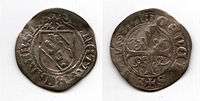Batzen
The batzen was a coin produced by Bern, Switzerland, from the 15th century until the mid-19th century.

Etymologically, the batzen is most likely named for the bear (Batz, Bätz, Standard German Petz), the heraldic animal of Berne that was depicted on the coins. Alternatively, the term could derive from a word for "lump, clod", as a colloquialism referring to the low quality of the silver or billon in the coin. Yet other hypotheses suggest that the name is related to the verb 'batter', meaning 'to mint', or that it is related to the Italian pezzo, 'piece'.[1] The batzen was originally a silver coin, but by the 17th century it was struck in billon. In Bern's monetary system, the batzen was worth four kreuzer.
The term batzen for a coin of low value soon spread beyond Berne, and batzen were minted in other Swiss cantons and southern German states.

With the introduction of the franc in the Helvetic Republic, a batzen became the denomination of one tenth of a franc, equivalent to 10 rappen or centimes. The Konkordatsbatzen of 1826 was a standardised coin issued by the cantons of Berne, Basel, Fribourg, Solothurn, Aargau and Vaud.
When the Swiss franc was introduced in 1850 as a common currency for all Swiss cantons, the batzen denomination was no longer officially used, but remained a colloquial term for the 10 rappen coin.
| Wikimedia Commons has media related to Batzen. |
References
- cf. Du Cange, s.v Baciones